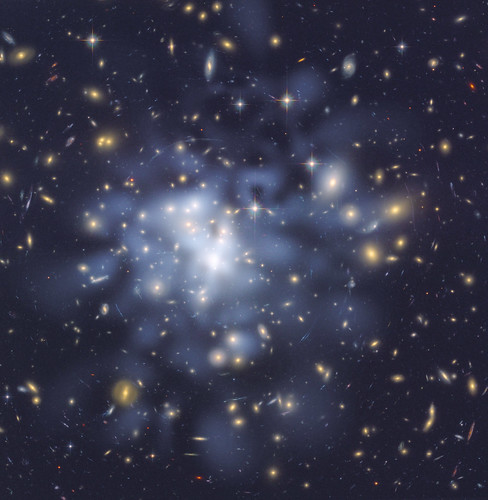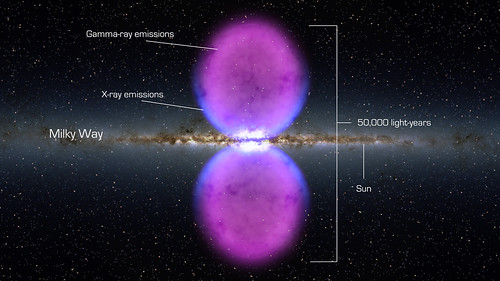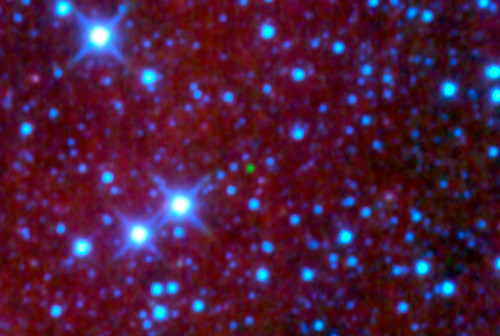Awesomeness Round-up – 11/16/10
- By Maggie Masetti
- November 16, 2010
- Comments Off on Awesomeness Round-up – 11/16/10
This recently released image is basically a map of dark matter. It shows the distribution of the dark matter in the center of the giant galaxy cluster Abell 1689, which contains an amazing number of galaxies (about 1000) and trillions (!) of stars. Abell 1689 is 2.2 billion light-years from Earth.
What is dark matter? It’s invisible and actually accounts for most of the universe’s mass. Since it’s invisible Hubble can’t see it directly but astronomers can infer its location by analyzing the effect of gravitational lensing. That is, the light from the galaxies behind Abell 1689 is distorted by intervening matter within the cluster. The observed positions of 135 lensed images of 42 background galaxies were used by researchers to figure out the location and amount of the dark matter in the galaxy cluster. This map of inferred dark matter concentrations (tinted blue) was superposed on an image of the cluster taken by Hubble’s Advanced Camera for Surveys (ACS) in 2002. How do they know this effect is real? Well, if the cluster’s gravity came only from the visible galaxies, the lensing distortions would be much weaker. The map reveals that the densest concentration of dark matter is in the cluster’s core.
NASA Goddard recently had a “Week in the Life of Goddard” contest. People took photos of life at Goddard, and a photo a day was selected and featured in Goddard’s Flickr. I have heard there will be an exhibition of photos at Goddard at some point too. Here is the whole set.
I like this one of cars leaving the back gate:
Our campus is actually quite pretty, and fall colors this year were particularly good:
This picture amused me the most though. At first I thought it was a mistake – that’s the restaurant featured in Seinfeld! Apparently, also in this building is the NASA Goddard Institute for Space Studies, located in New York City!
Another recent story in the news is that the Fermi Gamma-ray Space Telescope mission just discovered a previously unseen, large-scale structure in the Milky Way galaxy. It spans 50,000 light years might be the the remnant of an eruption from a supersized black hole at the center of our galaxy.
“What we see are two gamma-ray-emitting bubbles that extend 25,000 light-years north and south of the galactic center,” said Doug Finkbeiner, an astronomer at the Harvard-Smithsonian Center for Astrophysics in Cambridge, Mass., who first recognized the feature. “We don’t fully understand their nature or origin.”
You can read more in the NASA release, or watch this video!
Check out this amazing SDO observation of a x-ray solar flare. This is active sunspot 1121. It’s actually the brightest x-ray solar flare in a long time, an M5.4-class eruption. It occurred on Nov. 6th.
On November 12th, active sunspot 1123 erupted, producing a C4-class solar flare and apparently hurling a filament of material in the general direction of Earth. Coronagraph images from NASA’s twin STEREO spacecraft show a coronal mass ejection (CME) emerging from the blast site and heading off in a direction just south of the sun-Earth line. The cloud could deliver a glancing blow to Earth’s magnetic field sometime on Nov. 14th or 15th, sparking auroras.
View an animated gif, a still of which is below:
Lots of people have heard of white dwarf or red giant stars – but how about brown dwarfs? A brown dwarf is something that is bigger than a planet but too small to be a star. They are cool and faint, and thus hard to see. The infrared WISE telescope found this one (the green dot in the center of the image below) somewhere between 18 and 30 light years away, which astronomical speaking, is very close by. You can read more about brown dwarfs and this discover at Phil Plait’s blog.
This video comes courtesy of the Astrobiology Lab. Inge ten Kate talks about the origin of life, the VAPOR instrument, and the unique opportunity to be both a scientist AND an engineer.
We loved these whimsical photos of the Moon that play with perspective. There are more on the photographer’s website.









